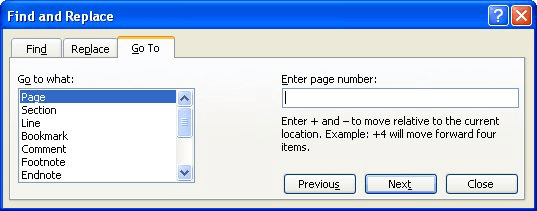Please Note: This article is written for users of the following Microsoft Word versions: 97, 2000, 2002, and 2003. If you are using a later version (Word 2007 or later), this tip may not work for you. For a version of this tip written specifically for later versions of Word, click here: Jumping to a Page within a Section.
Written by Allen Wyatt (last updated January 25, 2020)
This tip applies to Word 97, 2000, 2002, and 2003
Janis has a long, sectioned document and she wants to use the Go To feature (F5) to go to a specific page in a specific section. For example, she would like to use it to jump to section 4, page 18.
There are actually several ways you can go about navigating to the desired page. The first is to use two passes of the Go To feature:

Figure 1. The Go To tab of the Find and Replace dialog box.
Entering the plus sign in step 6 is important. If you don't do that and there is a section earlier in the document that has the same page number (for instance, perhaps section 2 also has a page 18), then it is the page in the earlier section that will be displayed.
There is an easier way to accomplish the same task, however, and it requires only a single use of the Go To dialog box. Follow these steps:
This approach to specifying a section number and a page number together may look familiar; it is the same approach you can use when specifying section pages you want to print. If you enter a page number in step 3 that is greater than the number of pages in the section, then Word takes you to the last page in that section. For example, if you entered s4p63 and there were only 47 pages in section 4, then Word takes you to the beginning of page 47.
There is a big caveat to using this simpler approach—it assumes that your document is formatted so that page numbering starts over at the beginning of each section. If, instead, your page numbering is continuous, then you'll need to use the two-pass method described at the first of this tip. If you use the second, shorter method, Word will simply take you to the first page in section 4 because there is no page 18 in the section; page 18 occurred earlier, in a previous section.
WordTips is your source for cost-effective Microsoft Word training. (Microsoft Word is the most popular word processing software in the world.) This tip (10268) applies to Microsoft Word 97, 2000, 2002, and 2003. You can find a version of this tip for the ribbon interface of Word (Word 2007 and later) here: Jumping to a Page within a Section.

Create Custom Apps with VBA! Discover how to extend the capabilities of Office 365 applications with VBA programming. Written in clear terms and understandable language, the book includes systematic tutorials and contains both intermediate and advanced content for experienced VB developers. Designed to be comprehensive, the book addresses not just one Office application, but the entire Office suite. Check out Mastering VBA for Microsoft Office 365 today!
When you are navigating around your document, you may find it helpful to jump a certain number of pages either toward the ...
Discover MoreIf you use the arrow keys to move the insertion point through the document, you may have noticed that it can be slow ...
Discover MoreJumping to a specific footnote can be very handy if your document has a lot of footnotes in it. Word provides the ...
Discover MoreFREE SERVICE: Get tips like this every week in WordTips, a free productivity newsletter. Enter your address and click "Subscribe."
There are currently no comments for this tip. (Be the first to leave your comment—just use the simple form above!)
Got a version of Word that uses the menu interface (Word 97, Word 2000, Word 2002, or Word 2003)? This site is for you! If you use a later version of Word, visit our WordTips site focusing on the ribbon interface.
Visit the WordTips channel on YouTube
FREE SERVICE: Get tips like this every week in WordTips, a free productivity newsletter. Enter your address and click "Subscribe."
Copyright © 2026 Sharon Parq Associates, Inc.
Comments